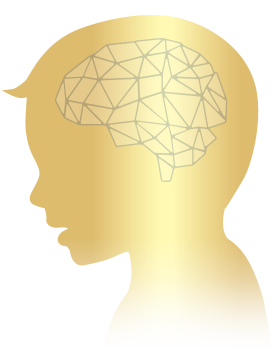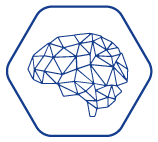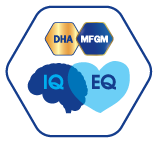Quick Facts About MFGM


Learn what MFGM is and why it's important during the toddler years
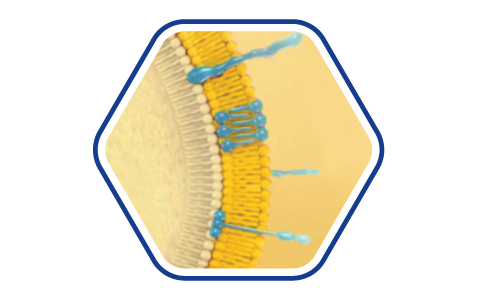
What is MFGM?
MFGM is a complex combination of lipids and proteins2.

Where is MFGM found?
Like DHA, MFGM components* are found abundantly in the brain3.

What does MFGM do?
MFGM components* produce brain chemicals, called neurotransmitter which carries information from one brain cell to another4,5. By helping brain cells to connect, they regulate mental abilities, emotions and mood6.
They also form a sheath that coats, insulates and protects nerve cells within the brain, helping them to become more stable to transmit information faster7,8.
They also form a sheath that coats, insulates and protects nerve cells within the brain, helping them to become more stable to transmit information faster7,8.

Breakthrough in pediatric nutrition
Thanks to advances in technology, MFGM fraction can now be extracted9. MFGM Complex is included for the first time in growing-up milk formula.

Balanced development to help support a bright future
With technological advances and accelerated changes in a borderless world, our children will be growing up in a vastly different world compared to ours. Having high IQ alone is not enough to succeed. The other half lies in EQ – the ability to communicate, understand emotions and cooperate.
While parental nurturance and a stimulating environment influences mental and emotional development, nutrition also plays a starring role.
Scientific studies show that MFGM works with DHA to help support mental10 and emotional11 development.
While parental nurturance and a stimulating environment influences mental and emotional development, nutrition also plays a starring role.
Scientific studies show that MFGM works with DHA to help support mental10 and emotional11 development.

References:
1Kennedy et. Al. Developmental Science. 2002;5(3):268-278.
2Kuchta-Noctor AM et al. Journal Nutrition and Cancer. 2016; 68(7)
3Svennerholm L et al. Journal of Lipid Research. 1968;9:570-579
4El-Loly M. Composition, Properties and Nutritional Aspects of Milk Fat Globule Membrane – a Review. Pol. J. Food Nutr. Sci. 2011; 61(1),7-32.
5Küllenberg D et al. Health effects of dietary phospholipids. Lipids in Health and Disease. 2012; 11(3),1-16
6Banjari I et al. Brain food: how nutrition alters our mood and behavior. Hrana u zdravlju i bolesti, znanstveno-stručni časopis za nutricionizam i dijetetiku, 2014; 3(1),13-21
7Kang, H. & Klauda JB. Biophysical Journal. 2015; 108(2), Supplement 1, p410a
8Melendez S. How to strengthen your brain. Melendez Publishing International. 2010; p98.
9Jukkola A et al. J Dairy Sci. 2016;99(1):8644-8654
10Kuratko, C.N. et al. Nutrients. 2013;5(7):2777-2810.
11Veereman-Wauters G et al. Nutrition. 2012;28:749-752
*MFGM components refer to phospholipids and sphingomyelin
Benefits for Your Child's Brain

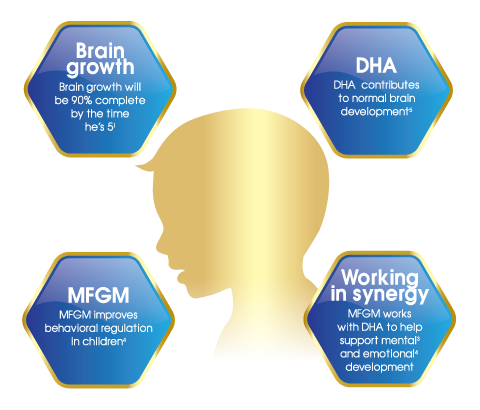
|
MFGM & DHA Scientific Studies
Cognitive Development
DHA has been shown to be associated with better reading and working memory performance6.
Emotional & Behavioral Regulation
The first five years of life is a critical period for the development of social competence that is linked to emotional well-being. It can affect a child’s later ability to functionally adapt in school and to form successful relationships throughout life.


MFGM components* promote production and transmission of neurotransmitters9,10 (substances that participate in the creation of brain cell connections) and thereby regulate mental abilities, emotions and mood11. They also form a sheath that coats, insulates and protects nerve cells within the brain, helping them to become more stable to transmit information faster12,13. Scientific study show that MFGM consumption leads to improved emotional and behavioral regulation in young children4.

Building Immunity
MFGM has been shown to have a protective effect against gastrointestinal infections, producing a significant decrease in the number of short febrile episodes4.
References:
1Lenroot RK and Giedd JN. Neuroscience and Biobehvaioral Reviews 2006; 30:718-729
2Accenture. 2017. Available at https://www.accenture.com/us-en/insight-iq-plus-eq [accessed on 18th April 2017]
3Kuratko CN. et al. Nutrients. 2013; 5(7), 2777-2810.
4Veereman-Wauters G et al. Nutrition. 2012;28:749-752
5EFSA NSDA Panel. EFSA Journal. 2014;12(10):3840, 8 pp. doi:10.2903/j.efsa.2014.3840
6Montgomery P et al. PLoS ONE. 2013; 8(6): e66697. doi:10.1371/journal.pone.0066697
7Sandjaja et al. British Journal of Nutrition. 2013; 110:S57-S64
8Graziano et al. J Sch Psychol. 2007;45(1):3-19
9El-Loly M. Pol. J. Food Nutr. Sci. 2011; 61(1),7-32.
10Küllenberg D et al. Lipids in Health and Disease. 2012; 11(3),1=16
11Banjari I et al. Hrana u zdravlju i bolesti, znanstveno-stručni časopis za nutricionizam i dijetetiku, 2014; 3(1),13-21
12Kang, H. & Klauda JB. Biophysical Journal. 2015; 108(2), Supplement 1, p410a
13Melendez S. How to strengthen your brain. Melendez Publishing International. 2010; p98.
*MFGM components refer to sphingomyelin and phospholipids
†Behaviour terms are adapted based on Merriam-Webster English Thesaurus.
